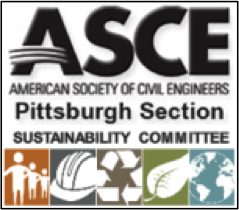 Tom Batroney, PE, ENV SP, M.ASCE – ASCE Pittsburgh Sustainability Committee Chair
Tom Batroney, PE, ENV SP, M.ASCE – ASCE Pittsburgh Sustainability Committee Chair
Jason J. Borne, PE, CPSWQ, ENV SP, M.ASCE – ASCE Pittsburgh Sustainability Committee Vice Chair
This is the second part in a series of ASCE-Pittsburgh articles related to the Envision Rating System. The first part of the series introducing the system can be read here.
The Envision Rating System, developed in part by the American Society of Civil Engineers, provides engineers a standardized tool for evaluating the level of sustainability for the diverse sectors of civil engineering infrastructure projects including:
- Transportation
- Parks
- Dams
- Energy
- Stormwater
- Water
- Wastewater
The intention of the rating system is to provide a holistic method for evaluating sustainability metrics throughout the life cycle of projects.
This installment of the article series discusses the five categories within the Envision Rating System: Quality of Life, Leadership, Resource Allocation, Natural World, and Climate and Risk. Each category is further subdivided into subcategories that include detailed credits. In total, the rating system is made up of 60 subcategory credits that evaluate a specific project component related to sustainability. The categories and subcategories are intended to capture the level of sustainability in a simple and understandable credit system approach. As more credits are accumulated within the categories and subcategories, the greater the overall sustainability rating of the project. These credits can then be applied for achieving an official Envision Certification Award for the project (Platinum, Gold, Silver, Bronze). The following is a short description of each category and subcategory.
Quality of Life
 Quality of Life addresses a project’s impact on host and affected communities. These impacts may be physical, economic, or social. Quality of Life focuses on assessing whether infrastructure projects align with community goals, are incorporated into existing community networks, and will benefit the community in the long term. Community members affected by the project are considered important stakeholders in the decision-making process. The category is further divided into three subcategories: Purpose, Wellbeing, and Community. Many of these questions address the question: “Are we doing the right project?”
Quality of Life addresses a project’s impact on host and affected communities. These impacts may be physical, economic, or social. Quality of Life focuses on assessing whether infrastructure projects align with community goals, are incorporated into existing community networks, and will benefit the community in the long term. Community members affected by the project are considered important stakeholders in the decision-making process. The category is further divided into three subcategories: Purpose, Wellbeing, and Community. Many of these questions address the question: “Are we doing the right project?”
Leadership
 The Leadership category addresses a team’s ability to communicate and collaborate with a wide variety of people in fostering ideas for a successful project. The category is subdivided into three subcategories: Collaboration, Management, and Planning. The credits for Collaboration pertain to involving stakeholders to capture ideas and foster innovation across project groups. The intent is to improve communication across teams and stakeholders allowing for cross pollination of ideas. The Management subcategory deals with creating collaborations between various systems within a project, thus reducing waste and often times cost. The Planning subcategory is intended to increase the project team’s awareness of long-term factors which may impact the project. Understanding planning issues, such as the regulatory environment and future growth trends in the area, can lead to a project that avoids pitfalls and plans effectively.
The Leadership category addresses a team’s ability to communicate and collaborate with a wide variety of people in fostering ideas for a successful project. The category is subdivided into three subcategories: Collaboration, Management, and Planning. The credits for Collaboration pertain to involving stakeholders to capture ideas and foster innovation across project groups. The intent is to improve communication across teams and stakeholders allowing for cross pollination of ideas. The Management subcategory deals with creating collaborations between various systems within a project, thus reducing waste and often times cost. The Planning subcategory is intended to increase the project team’s awareness of long-term factors which may impact the project. Understanding planning issues, such as the regulatory environment and future growth trends in the area, can lead to a project that avoids pitfalls and plans effectively.
Resource Allocation
 The Resource Allocation category addresses the materials used in the construction and operation for the lifespan of the project. The category is subdivided into three subcategories: Materials, Energy, and Water. For each subcategory, the quantity, source, and characteristics of these resources and their impacts on the overall sustainability of the project are assessed. In general, the category assesses the ability of the project to limit the amount of:
The Resource Allocation category addresses the materials used in the construction and operation for the lifespan of the project. The category is subdivided into three subcategories: Materials, Energy, and Water. For each subcategory, the quantity, source, and characteristics of these resources and their impacts on the overall sustainability of the project are assessed. In general, the category assesses the ability of the project to limit the amount of:
- Finite materials used on the project,
- Non-renewable fossil fuel energy sources, and
- Water consumption.
There are also additional credits for emphasizing monitoring systems during operations.
Natural World
 Infrastructure projects have an impact on the natural world around them, including habitats, species, and nonliving natural systems. The way a project is located within these systems can create unwanted impacts if not properly accounted for in design and operation. The Natural World category addresses how to understand and minimize negative impacts while considering ways in which the project can interact with natural systems in a positive way. The Natural World category is subdivided into three subcategories: Siting, Land and Water, and Biodiversity. In general, these subcategories address the project’s ability to limit the environmental impact on the surrounding landscape and habitat.
Infrastructure projects have an impact on the natural world around them, including habitats, species, and nonliving natural systems. The way a project is located within these systems can create unwanted impacts if not properly accounted for in design and operation. The Natural World category addresses how to understand and minimize negative impacts while considering ways in which the project can interact with natural systems in a positive way. The Natural World category is subdivided into three subcategories: Siting, Land and Water, and Biodiversity. In general, these subcategories address the project’s ability to limit the environmental impact on the surrounding landscape and habitat.
Climate and Risk
 The Climate and Risk category addresses potential short term and long term climate change and risk management of the project. The category is divided into two subcategories: Emissions and Resilience. The Emissions subcategory evaluates the projects ability at reducing greenhouse gas and air pollutant emissions during the full life span of the project (construction and startup activities, operations, and decommissioning.) The Resilience subcategory evaluates the projects ability to be adaptable to potential changes in environmental conditions, both in the short term and the long term.
The Climate and Risk category addresses potential short term and long term climate change and risk management of the project. The category is divided into two subcategories: Emissions and Resilience. The Emissions subcategory evaluates the projects ability at reducing greenhouse gas and air pollutant emissions during the full life span of the project (construction and startup activities, operations, and decommissioning.) The Resilience subcategory evaluates the projects ability to be adaptable to potential changes in environmental conditions, both in the short term and the long term.
The intent of the second part of the article series was to provide a high level overview of the credits within the Envision Rating System. For more in-depth information, visit the Envision website at http://www.sustainableinfrastructure.org/. The next installment of the Envision Rating System article series will focus on the companion tools available within the Envision Rating System, including the planning level Self-Assessment Checklist Tool, and the Business Case Evaluator Tool for assessing economic return benefits for sustainable design.
For more information on becoming involved within ASCE Pittsburgh’s Sustainability Committee visit our webpage at: http://www.asce-pgh.org/SustainabilityCommittee
